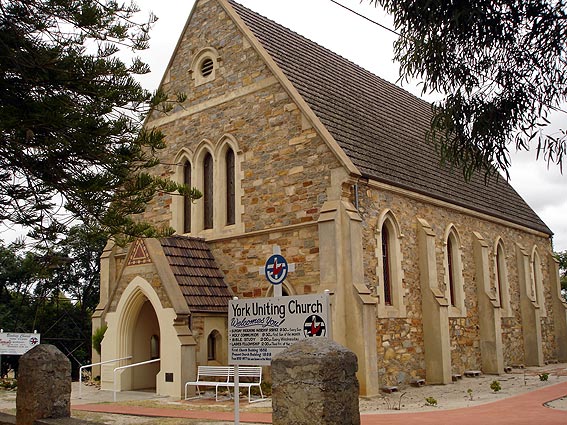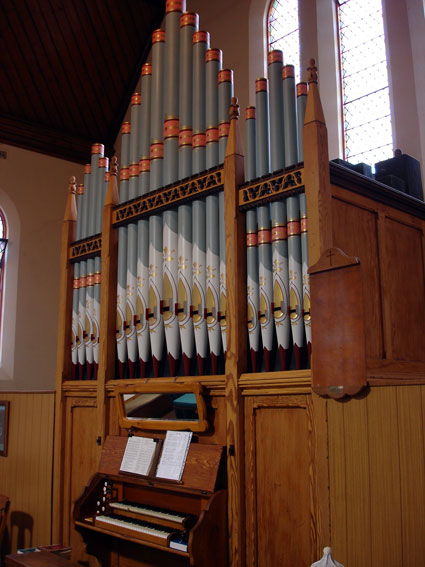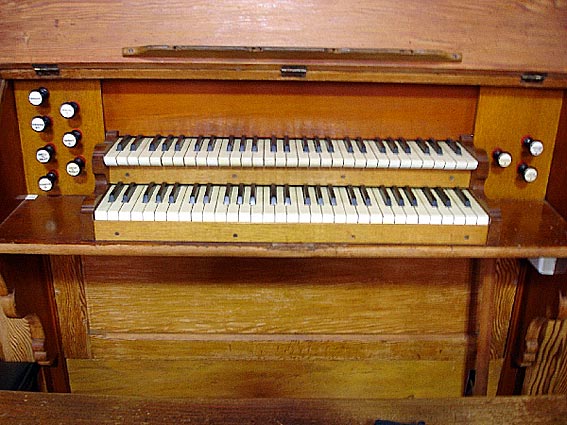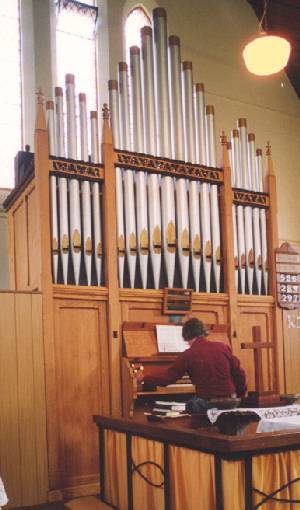Wesley Uniting Church
York
Alfred Monk, London; installed 1895
2 manuals, 7 speaking stops, mechanical action
Photo: Bruce Duncan
An organ built by the firm of Alfred Monk of London was installed in the church in 1895.
GREAT
Open Diapason
Claribel
Harmonic Flute
SWELL
Violin Diapason**
Gedeckt
Principal
PEDAL
Bourdon
COUPLERS
Swell to Great
Great to Pedal
8
8
4
8
8
4
16
C-ggg, 56 notes
metal, open 56 pipes
metal/wood, stopped 56 pipes
metal, open 56 pipes
Enclosed, C-ggg, 56 notes
now Gemshorn 8, metal, open 56 pipes
wood, stopped 56 pipes
metal, open 56 pipes
C-f, 30 notes
wood, stopped 30 pipes
** The Violin Diapason was recently replaced by a Gemshom 8 by F.J. Larner and Co.
The organ was hand blown until 1929 when an electric blower was fitted. The names of many of the organ blowers were carved into the organ case, put there by the blowers themselves. Unfortunately these names were removed in an attempt to refurbish the case.
The following information and history was supplied by Bruce Duncan (Jan. 2008):
Built 1895 Alfred Monk, London, United Kingdom.
Casework and frame is in Pitch Pine.
Console type: Integrated
Stop controls: drawknob, flat arrayed SW and Ped on left, GT on right
Pedals type: concave/flat
Key action: mechanical
Stop action: mechanical
Pitch: a1 in Hz 440
Wind power: Electric, one double rise reservoirs, wooden trunking throughoutTwo manual and pedal tracker action with 7 ranks of pipes and 7 speaking stops. Number of pipes: 366.
Originally located on a raised platform, now located free standing on the floor of the church.HISTORY
Restoration work 1904 J .E. Dodd (no detail recorded)
Electric blower replaced hand blowing mechanism 1929
Relocated from front choir gallery to floor of church. Overpainting of original case and pipe colours. c1960
Restored 1982 F.J. Larner & Co. Tonal adjustments and refurbishment (no detail recorded), Possible stripping back of case to remove black overpainting . Pipes remain overpainted in silver.
Tonal alteration 1990 F.J. Larner & Co. Gemshorn substituted for Swell Violin Diapason.
Refurbished 2001 F.J.Larner & Co. Pipework cleaned, leathers and felt replaced.
Pipework stencilling to restore remnant of original diapering 2001 Pipe Organs of WA
New wood wind trunking to replace flexible tubing 2003 Pipe Organs of WA
Photo: Bruce Duncan



